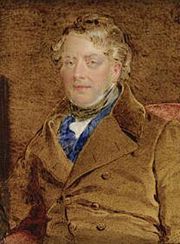Edward Ellice (merchant)
Edward Ellice | |
|---|---|
 Painting by Sir Charles William Ross | |
| Secretary at War | |
| In office 1833–1834 | |
| Preceded by | Sir John Hobhouse |
| Succeeded by | John Charles Herries |
| Financial Secretary to the Treasury | |
| In office 1830–1832 | |
| Preceded by | Office created |
| Succeeded by | Charles Wood |
| Personal details | |
| Born | 27 September 1783 London, England |
| Died | 17 September 1863 (aged 79) Glengarry, Scotland |
| Spouse(s) |
Lady Hannah Bettesworth
(m. 1809)Anne Coke
(m. 1843; died 1844) |
| Children | Winchester School |
| Alma mater | Marischal College, University of Aberdeen University of St Andrews |
Edward Ellice the Elder (27 September 1783 – 17 September 1863), known in his time as the "Bear", was an English merchant and politician. He was a Director of the
Biography
Ellice was born on 27 September 1783 in London, the son of Alexander Ellice and Ann Russell. In 1795, his father purchased the Seigneury of Villechauve in Canada from Michel Chartier de Lotbinière, Marquis de Lotbinière. His younger brother was General Robert Ellice.
He was educated at
He engaged in the Canada fur trade from 1803, and as a result was nicknamed "the Bear". On 30 October 1809 he married Hannah Althea Bettesworth, née Grey, daughter of
In 1820, he was, with the brothers William and Simon McGillivray, active in bringing about the union of the North West and the Hudson's Bay Companies; and it was actually with him and the McGillivrays that the union was negotiated. He amalgamated the North West, XY, and Hudson's Bay companies in 1821.
In 1825 Ellice was a director of the New Zealand Company, a venture chaired by his brother-in-law, the wealthy John George Lambton, Whig MP (and later 1st Earl of Durham), that made the first attempt to colonise New Zealand. His brother Russell Ellice was also a director.[1][2][3]
He was
He was awarded a DCL by
Ellice was a co-owner of eight sugar estates in Grenada, British Guiana, Tobago and Antigua. In the 1830s, the British government emancipated the slaves, and Ellice received £35,000 in compensation for the liberation of over 300 slaves.[5]
In 1843, he married, secondly, Anne Amelia Leicester, née Keppel, daughter of
His brother General Robert Ellice married Eliza Courtney; one of their grandsons became his son's heir in 1880.
Sporting interests
On returning from Canada in 1838, Ellice bought the estate of Glenquoich in Lochaber,[6] and built a lodge on the shores of Loch Quoich designed by Inverness architect Alexander Ross. In the summer and autumn months he entertained a wide range of guests there, including artists, writers, statesmen and diplomats.
In the 1840s Ellice was also a shooting tenant on
Legacy
The
are named after him.See also
References
- ISBN 978-1-927277-19-5. Retrieved 9 December 2020.
...first published in 1977.
- ^ McDonnell, Hilda (2002). "Chapter 3: The New Zealand Company of 1825". The Rosanna Settlers: with Captain Herd on the coast of New Zealand 1826-7. Archived from the original on 28 February 2009. Retrieved 9 December 2020.
including Thomas Shepherd's Journal and his coastal views, The NZ Company of 1825.
{{cite book}}:|website=ignored (help) - Wakefield, Edward Jerningham (1845). Adventure in New Zealand, from 1839 to 1844: With Some Account of the Beginning of the British Colonization of the Islands. John Murray. p. 4. Retrieved 9 December 2020.
Digitised 22 July 2009
- ^ Leigh Rayment's Historical List of MPs
- ^ "Summary of Individual | Legacies of British Slavery".
- ^ ISBN 9781910900987
- ^ History in Winnipeg Street Names at the Manitoba Historical Society
Bibliography
- W. Stewart Wallace, ed. (1948). The Encyclopedia of Canada, vol. II. Toronto: University Associates of Canada. pp. 287–288.
{{cite encyclopedia}}: Missing or empty|title=(help) - Colthart, James M. (1976). "Edward Ellice". ISBN 0-8020-3319-9.)
{{cite book}}: CS1 maint: location missing publisher (link - Watkin, Edward William. Canada and the States. Forgotten Books. ISBN 1-60620-892-6.
- "Archival material relating to Edward Ellice". UK National Archives.
- "Our History: Acquisitions". Hudson's Bay Company. Retrieved 12 April 2009.
